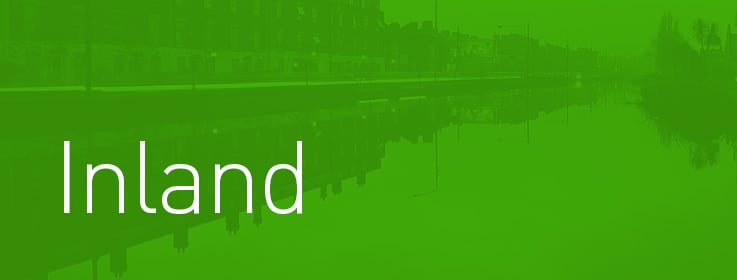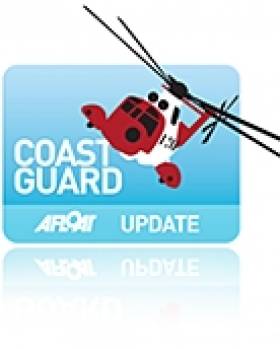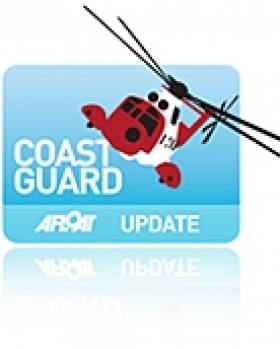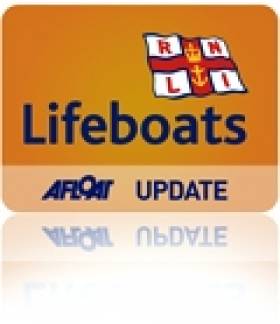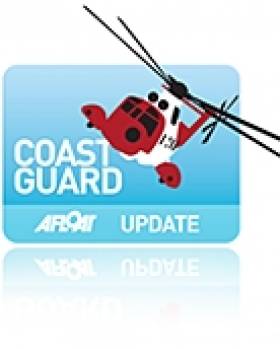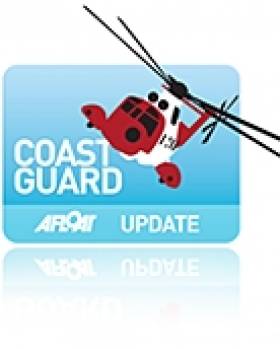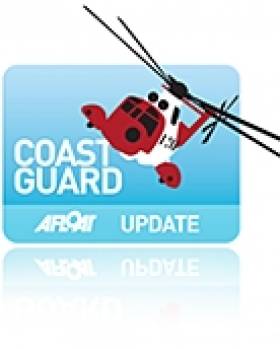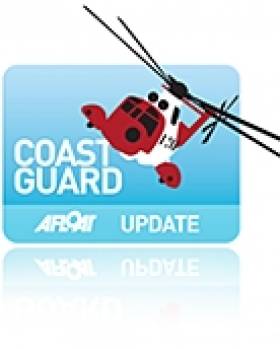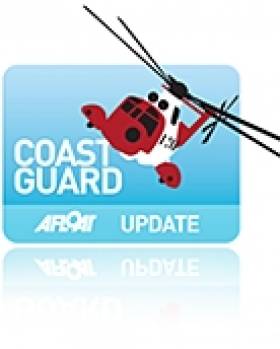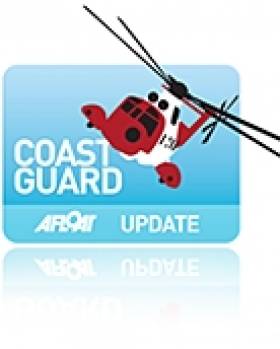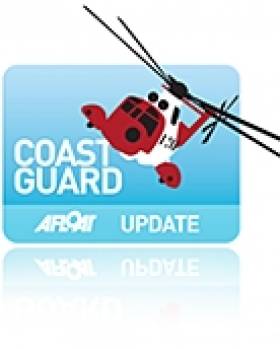Displaying items by tag: Coastguard
Two Canoeists Call for Help from Belfast Coastguard
The emergency call stated that the two men, both in their early 50s, were off Copeland Sound between the coast and Donaghadee. Both men were wearing lifejackets. The man in difficulty was exhausted and needed assistance. The seas on scene were described as having a heavy swell.
Both the Bangor and Donaghadee RNLI inshore lifeboats were asked to launch and a fisheries patrol vessel, the 'Queen of Ulster' also offered assistance after hearing the radio exchanges.
During the incident, Belfast Coastguard kept in contact with the canoeist who had remained in his craft to ensure that both men were aware of the situation and that help was proceeding.
Louis McGookin, Duty Watch Manager at Belfast Coastguard said
"It was clear that the man in the water was absolutely exhausted and simply was unable to get back into his craft. Sea temperatures are at around 8 degrees Celsius at present and hypothermia is an ever present danger in prolonged immersion. Fortunately they were able to contact the Coastguard and using our knowledge of the tides in the area we were able to pinpoint his location. Both men were given a medical check when they arrived back at the shoreline and neither required any treatment."
Related Safety posts
RNLI Lifeboats in Ireland
Safety News
Rescue News from RNLI Lifeboats in Ireland
Coast Guard News from Ireland
Water Safety News from Ireland
Marine Casualty Investigation Board News
Marine Warnings
Search Underway for Missing Ferry Passenger
The vessel had departed from Larne at 07.24 this morning and arrived at Cairnryan two hours later at a speed of approximately 18 knots. The master of the vessel has confirmed that one person is missing from the ships manifest.
The sea conditions are currently calm with a slight swell and good visibility with south westerly winds of 5 knots between the two locations.
A rescue helicopter, R 177, has been scrambled from the Royal Naval Air Station at Prestwick.
Clyde Coastguard are now organising a search throughout the area taking into account tidal drift and winds. Coastguard Rescue Teams have now been turned out ready to search the shores of Loch Ryan.
The Portpatrick, Stranraer and Larne RNLI lifeboats have all been requested to launch. A search has also begun from Cairnryan to Finnarts Bay. The Police Service of Northern Ireland has also been informed.
A mayday signal has now also been broadcast into the area by the Coastguard to alert passing shipping to the unfolding incident.
Fisherman Still Missing off Cork Harbour
UPDATE: Ballycotton RNLI lifeboat has launched this morning to help search for a missing person off Ringabella Bay in Cork Harbour. The alarm was raised when one fisherman managed to swim ashore shortly before 11am and alert the emergency services that another man was still in the water. A major air and sea search is currently taking place in the area for the missing fisherman. Ballycotton RNLI lifeboat, Crosshaven RNLI lifeboat, Coastguard helicopter Rescue 117 and the naval service have gathered in the area and a coordinated search is taking place.
Related Safety posts
RNLI Lifeboats in Ireland
Safety News
Rescue News from RNLI Lifeboats in Ireland
Coast Guard News from Ireland
Water Safety News from Ireland
Marine Casualty Investigation Board News
Marine Warnings
Coast Guard Statistics Show more than 3,500 people assisted, a 20% increase on 2009
Today, the Irish Coast Guard published details of incidents responded to in 2010, which show the following important trends:
A total of 3,570 persons were assisted last year, a 20% increase on the 2009 figure. Total number of incidents responded to in 2010 was 1,839, consistent with total for 2009. A notable decrease in number of incidents involving leisure/recreational activities. The number of fatalities the Coast Guard responded in 2010 was 49, consistent with 2009.
Speaking today, Declan Geoghegan, Manager of the Irish Coast Guard said: "A total of 3,570 people were assisted by the Irish Coast Guard last year. The 20% increase on the 2009 figures is mainly due to the severe weather conditions at the end of 2010, when the Coast Guard provided assistance to all areas of the community including to An Garda Siochana, to local authorities but mainly to the HSE where transportation of patients, staff and GP's to various medical centres was required for a lengthy period. The Coast Guard also provided assistance to the farming community by airlifting animal feed during the severe weather."
Mr. Geoghegan continued: "A very positive development from the statistics, is the notable decrease in the number of incidents we responded to last year that involved leisure/recreational activites; the main ones being those that involved leisure craft and separately, diving incidents. This is directly attributable to the major effort that was made by the Marine Safety Working Group (chaired by the Irish Coast Guard at the Department of Transport) in alerting people to the dangers of these activities. In particular, the Marine Safety Working Group last year targeted tourists and newcomers to Ireland who may be unfamiliar with our coastline and geography and the dangers associated with it. The Marine Safety Working Group has produced safety leaflets aimed at the public (in English and other languages) to alert them to dangers and separately, to provide assistance when selecting equipment and planning trips."
The Irish Coast Guard responded to a total of 1839 separate incidents in 2010 which is constant with the 2009 figures, while the number of fatalities responded to has also remained constant with 2009 at a total of 49.
Mr. Geoghegan continued: "While it is welcome news that the number of incidents and fatalities the Coast Guard has responded to remained stable in 2010, a notable feature of the statistics show a marked increase in the number of hoax, nuisance calls and false alarms. We are working closely with an Garda Siochana in addressing hoax calls. Coast Guard Units right around Ireland are on standby today, as we are 24/7 to respond to incidents, to provide assistance and to save lives; maybe even yours. This is important work and something we take very seriously indeed."
Mr. Geoghegan concluded: I wish to take this opportunity to pass on some key messages from the Coast Guard to members of the public for 2011. These are:
If you are planning a trip along our coastline, or engaging in recreational activities in the sea or on inland waterways, plan your trip/activity carefully
Advise someone ashore of your plans
Check weather and tides
Check your craft and equipment
Know the area for boating, swimming, or angling
Never, ever go out alone.
If you see someone in difficulty, call 999 or 112 and ask for the Coast Guard.
Fishermen Rescued From Sinking Vessel off Ardglass
Belfast Coastguard received a Mayday call at 5:54pm from the Newry registered vessel, which operates out of Ardglass, and immediately sent the Southdown and Portaferry Coastguard Rescue Teams to the scene. The launch was requested of the RNLI Portaferry inshore lifeboat. The Irish Coastguard Rescue Helicopter was tasked but was later stood down.
Steve Carson, Watch Manager, Belfast Maritime Rescue Coordination Centre, said:
"The crew aboard the fishing vessel were rescued by the inshore lifeboat and then taken to Ardglass Harbour where they received medical attention; one of the crew has since been taken to Downpatrick Hospital.
It is imperative to always ensure you are carrying the correct safety equipment and have it serviced regularly. Due to the prompt and appropriate action of the crew I am pleased to say they are all safe but shaken by their traumatic experience.
The rescue was successfully coordinated by Belfast Coastguard with assistance from their colleagues at Dublin, Liverpool and Holyhead Coastguard Stations.
The vessel has now been successfully refloated and is now alongside in Ardglass Harbour."
Coastguard Rescue Teams Assist NHS in Snow Affected Areas
Cemaes Coastguard Rescue Team transported critical staff from Llanddeusant to Cefni Hospital, Llanerchymedd and Llangefni to Ysbyty Gwynedd then to Amlwch on return to base at Cemaes.
Moelfre Coastguard Rescue Team transported critical staff from Amlwch, Pentraeth and Talwrn to Ysbyty Gwynedd.
Moelfre Coastguard Rescue Team was tasked to assist the district nurse on critical care patient rounds, in the Gaerwen area.
Penmon Coastguard Rescue Team was tasked to collect a doctor from Llanddona and take them to Ysbyty Gwynedd.
Holyhead Coastguard Rescue Team was tasked to assist the district nurse on critical care patient rounds, in the Holyhead area.
These teams of volunteer coastguard rescue officers have been involved in essential drug transfers to and from local hospitals and nursing staff transfers. Essential supplies for critically ill patients have been delivered and doctors have been taken by coastguards to where they are needed in an emergency. Several teams are also on standby to assist over the weekend.
Rod Johnson, Chief Coastguard said
In extreme winter weather our partner emergency services, and local authorities, may need to call on our help to resolve critical or life threatening incidents. To make sure that we respond to these calls and maintain our own state of readiness for maritime emergencies, these requests are routed through the local resilience forum.
The system of call outs has been working well this week and ensuring that Her Majesty's Coastguard give help where it's needed; when it's needed.
NI Coastguard Centre Faces Scale Back, Possible Closure
The UK's shipping minister has announced proposals that would see a reduction in operational hours or even the closure of Northern Ireland's coastguard command centre.
Earlier this week news emerged that the rescue command centre at Bangor was under threat by public spending cuts.
Now the News Letter reports that Minister Mike Penning's proposals would see only three 24-hour coastguard stations across the UK - in Aberdeen, Southampton and Dover - with five sub-centres operating in daytime hours, one being based either at Bangor or Liverpool.
Campaigners have voiced their opposition to any reduction in Northern Ireland's local coastguard service. North Down independent MP Lady Sylvia Hermon told the News Letter that it was vital a well trained and equipped service was retained in the area.
Single Handed Yachtsman Caught in Gale Calls for Assistance
The yacht owner had been seeking permission to come into the harbour seeking a safe haven as the weather conditions had begun to deteriorate, and the Coastguard were alerted by the harbour authorities. The harbour authorities expressed concern at the time about the condition of the vessel, a 22 foot, single masted, single person crewed vessel with a blue hull. The weather forecast was suggesting westerly winds of 21 to 29 knots at St Bees Head.
However by 5.40 am the yacht still endeavouring to keep out of the weather and he reported to the harbour authorities that he had taken a lot of water into his vessel. He was reassured by the authority that the Coastguard had been informed and the Whitehaven Coastguard Rescue Team were turned out. The Workington RNLI all weather lifeboat were also requested to launch.
By now the wind was gusting 42 knots and had turned to the north west which meant it was blowing straight into the harbour and causing the skipper major problems as the vessel was being thrown against the pier in the outer harbour. He was trapped in his cabin.
The Cumbria Coastguard Sector Manager was also alerted, and an ambulance called.
By 6.30 this morning the RNLI all weather boat had arrived and deploying their small 'Y' boat they sent two crew members across to the 'Tern' to get the skipper out from the badly flooded yacht. In the confined activities, one Coastguard Team Member was hit by the flailing mast and was taken to hospital. The skipper of the yacht was also taken to hospital suffering from hypothermia.
Paul Campbell, Watch Manager at Liverpool Coastguard said
"This was quite an awkward job in very difficult and deteriorating weather conditions. Fortunately the skipper is now safely in hospital and our own Coastguard Rescue Officer was given a check by the A&E department and discharged."
Stornoway Helicopter Reports Busiest Year Ever
Scottish Coastguard rescue helicopter based in Stornoway has recorded its busiest ever year after clocking up in excess of 200 callouts in 2010.
It is the first time the rescue helicopter team has reached the milestone figure for missions in any one year, traditionally responding to an average of 136 callouts between January 1 and December 31. Since the introduction of the new technology S92 helicopters in 2007 however this has risen to an average of 190.
Leading search and rescue (SAR) service provider CHC Helicopter has operated the service for the Maritime and Coastguard Agency in the UK since 2007 from four bases at Stornoway, Sumburgh, Lee on Solent and Portland. Through its membership of the Soteria consortium, it has been identified as the preferred bidder on the UK SAR-H program, a 25-year contract to provide helicopter-based SAR services from 12 bases throughout the UK.
Ian McLuskie, UK SAR Business Unit Leader at CHC said: "The past three years have been the busiest we've ever had in terms of callouts and this is due to the capability of the S92 aircraft which are able to fly faster and further than those previously in use.
"This increased operating range and speed allows us to get to locations quicker, the overall result is a reduction in the time taken to rescue and get medical aid to those in need. This has allowed the unit to be called out to a greater number of jobs throughout the year, bringing the search and rescue service to a greater number of people and helping to save many more lives."
The Stornoway unit conducted its 200th mission on December 10th when rescue helicopter R100 was scrambled to evacuate a 57-year-old female who required urgent hospital treatment after experiencing breathing difficulties. The patient was transferred to Raigmore Hospital in Inverness.
NI Coastguard Centre May Face Closure
Public spending cuts in the UK could see the closure of Northern Ireland's only coastguard rescue command centre, the News Letter reports.
The coalition government is expected to announce phasing out of a number of the UK's 19 coastguard centres - and a member of the NI Coastguard said that "Bangor is certainly under threat".
The command centre in Bangor oversees coastguard operations along the entire coastline from Lough Foyle to Carlingford Lough, and has handled more than 700 incidents so far in 2010.
The staff member added: "The coastguard here in Northern Ireland is already over-stretched, and we firmly believe that the closure of our centre in Bangor will have a serious and detrimental effect on our ability to respond to emergencies here."
Margaret Elliot - the mother of teenage drowning victim James Elliot, who died in the flood-swollen River Bush in Co Antrim last year – has described the proposed cutbacks as "absolutely disgusting".
"We simply cannot allow this essential service to be threatened in any way. Saving money should never be a factor when it comes to saving lives," she said.
The News Letter has more on the story HERE.



























